纳米储氢材料原理及示意图
储氢材料

储 氢 材 料
The brief introduction of hydrogen storage materials
什么是储氢材料?
在一定的温度和压力条件下,能 可逆地吸收和释放氢气的材料,可 作为储氢材料。
储氢材料应具备的特点: 1、低释氢温度
2、吸收—放氢过程可逆
3、材料稳定,安全,无毒,低成本
储氢合金按组成元素的主要种类分为:镁系、稀土系、
钛系、锆系、铁系五大类。
按主要组成元素的原子比分为:AB5型、AB2型、AB 型、
A2B型,其中A是容易形成稳定氢化物的发热型金属元素,B 为难于形成氢化物的吸热型元素,且A原子半径大于B原子半 径。 A如:Ti、Zr、La、Mg、Ca、 Mm(混合稀土金属)等。
单壁纳米碳管束TEM 照片
多壁纳米碳管TEM 照片
2.2.2 碳纳米管材料的制备及研究方法 制备方法 电弧法 气相沉积法
低分子化合物
加载气(H2) 金属微粒催化剂
气相生长
1000~1400°C
碳纤维(或纳米管) 石墨化
2000~3000°C
表面处理
产品
石墨纤维 (或纳米管)
研究方法
有机液态氢化物主要包括苯、甲苯、萘等,人们现在主 要用苯及甲苯来储氢。
有机液体氢化物储氢的优、缺点
有机液体储氢技术与传统的储氢技术(深冷液化、金属氢化 物、高压压缩)相比具有以下优点:
①储氢量大 苯和甲苯的理论储氢质量分数分别为7.19%和 6.18%,比传统的金属氢化物、高压压缩的储氢量大得多。
MOF-5的吸附等温线78K
MOF-5的吸附等温线298K
温度、压力对其储氢性能的影响
纳米材料在储氢材料中的应用研究

纳米材料在储氢材料中的应用研究随着全球能源危机的日益严重,寻找新型的清洁可再生能源已成为全球人民的共同关注点。
其中,氢能源作为一种绿色、高效的能源形式,备受关注。
然而,氢能源的储存和运输一直是限制其广泛应用的主要难点之一。
传统的气体和液态氢储存方式在储存密度、安全性和可靠性等方面存在诸多问题。
近年来,纳米材料在储氢材料中扮演着越来越重要的角色,被认为是一种重要的氢储存方法。
本文将介绍纳米材料在储氢材料中的应用研究进展。
一、氢能源储存问题氢能源具有高效、清洁、环保等多种优点,是未来燃料的主要候选者之一。
然而,氢能源的储存和运输是目前亟需解决的问题。
传统的气体和液态氢储存方式存在容器体积大、储存密度低、易燃等诸多问题,因此被认为不是可持续的氢储存方法。
而化学吸附和物理吸附则是目前可行的氢储存方案之一。
二、纳米材料储氢原理纳米材料储存氢气的原理主要是物理吸附和化学吸附。
在物理吸附中,氢分子在纳米材料表面被吸附;而在化学吸附中,氢分子与纳米材料中的原子强烈相互作用,形成氢化物。
纳米材料的储氢密度与其表面积有关。
表面积越大,储氢量就越大。
因此,采用纳米材料作为储氢材料可以增加储氢密度,在保持储氢安全的前提下实现高效的储氢。
三、纳米材料在储氢中的应用研究1.金属有机骨架储氢金属有机骨架是一种由金属离子和有机配体组成的三维网状结构。
研究发现,金属有机骨架具有良好的储氢性能。
例如,Mg(OH)-BTB(BTB为2,3,6,7,10,11-三苯基二氮并[1,2-b:4,5-b']二嘧啶的缩写)材料具有较高的氢吸附容量和吸附热,是一种理想的氢储存材料。
2.纳米孔道材料储氢生物学家正在对许多纳米孔道材料开展深入研究。
目前,已开发出许多独特的纳米孔道材料,例如碳纤维、氧化锆等。
这些材料具有很高的表面积和孔体积,因此可以容纳大量的氢分子。
研究发现,一些材料,如MIL-101材料,可实现高达5.5 wt%的氢储存容量。
碳纳米管—储存氢气

Байду номын сангаас
3)化学气相沉积法(CVD法) CVD法是通过烃类(如甲烷、乙烯、苯等)或 含碳氧化物(如CO等)在催化剂(如过渡族金 属Fe、Co、Ni、Cr、Cu等)作用下裂解并重 构而制备CNTs的方法。1993年,Yacaman 以2.5%Fe/石墨颗粒为催化剂、乙炔为 碳源,首次针对性的采用该方法合成出长 度509m、直径和结构与TOima报道结果相 当的MWNTs。
25.7 0 3.3 29 12.2*
35 0 18.2 21.74 16.3
*未计算重整系统的质量。
各种储氢方法的体积比较
常规 汽油 燃料体积(L) 20 甲醇 液氢 压缩储氢 (306kg/cm2) 128.8 金属储氢合金 (2%) 58 纳米碳储氢 (8%) 47.89
32
50
储罐体积(L)
碳纳米管吸附氢的优点与缺点可归纳如 下:
优 点 缺 点
储氢能力大,可达9.9 wt% 吸附速率快,数小时内完成 室温吸附, 解吸速率快,数十分钟内完 成 可直接获得氢气,不需重整 器,使用方便
吸附压力须 100kg/cm2 钢瓶的体积和质量 仍较大 目前价格较高
展望
常用的储氢方法及其优缺点
储氢方法 压缩气体 液氢 金属氢化物 优点 缺点 运输和使用方便、 压力高,使用和运输有危险;钢 可靠 瓶的体积和重量大,运费较高 储氢能力大 储氢过程储氢能耗大,使用不方 便
运输和使用安全 储氢量小,金属氢化物易破裂
宝马旗下的研发部门-BMW Group Forschung und Technik,展示的一 款新型的车用储氢罐的原 型。这个新型液态氢储存 罐由复合材料构成。
纳米储氢合金制备方法

纳米储氢合金制备方法一、化学气相沉积法化学气相沉积是一种常用的制备纳米材料的方法,通过控制反应条件,如温度、压力、气体流量等,可以在较低的温度下制备出高纯度的纳米材料。
该方法可用于制备纳米储氢合金,通常将合金材料放置在高温炉中,通入氢气等反应气体,通过化学反应生成储氢合金纳米颗粒。
二、物理气相沉积法物理气相沉积法是一种制备纳米材料的方法,通过将材料加热到熔融状态后迅速冷却,再通过物理方法将固态颗粒分散到气体中,形成纳米颗粒。
该方法可用于制备纳米储氢合金,通常将储氢合金材料加热到熔融状态,再通过物理方法将熔融状态的合金分散到气体中,形成纳米颗粒。
三、溶胶凝胶法溶胶凝胶法是一种制备纳米材料的方法,通过将前驱体溶液在恒温下进行水解和聚合反应,形成溶胶,再将溶胶干燥、烧结后得到纳米材料。
该方法可用于制备纳米储氢合金,通常将前驱体溶液混合储氢合金元素,通过水解和聚合反应形成溶胶,再将溶胶干燥、烧结后得到纳米储氢合金。
四、微乳液法微乳液法是一种制备纳米材料的方法,通过将两种互不相溶的溶剂混合在一起,形成微乳液,再通过控制反应条件制备出纳米颗粒。
该方法可用于制备纳米储氢合金,通常将储氢合金元素溶解在油性溶剂中,再与水性溶剂混合形成微乳液,通过控制反应条件制备出纳米储氢合金。
五、机械合金化法机械合金化法是一种制备纳米材料的方法,通过将金属粉末在高能球磨机中球磨一定时间,使粉末颗粒细化并发生固态反应形成合金粉末。
该方法可用于制备纳米储氢合金,通常将储氢合金元素粉末放入球磨机中球磨一定时间,使粉末颗粒细化并发生固态反应形成纳米储氢合金粉末。
六、高能球磨法高能球磨法是一种制备纳米材料的方法,通过将金属粉末和研磨球在高能球磨机中球磨一定时间,使粉末颗粒细化并发生固态反应形成合金粉末。
该方法可用于制备纳米储氢合金,通常将储氢合金元素粉末放入球磨机中球磨一定时间,使粉末颗粒细化并发生固态反应形成纳米储氢合金粉末。
七、电解还原法电解还原法是一种制备纳米材料的方法,通过电解熔融盐中的金属离子并在阴极上还原生成金属或合金。
储氢材料的贮氢原理及应用
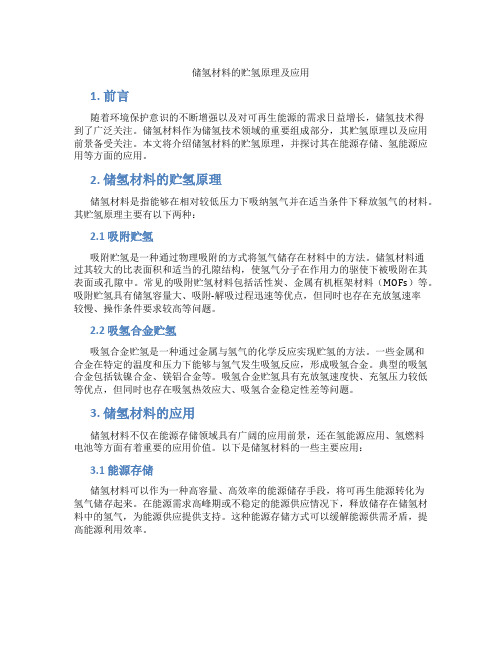
储氢材料的贮氢原理及应用1. 前言随着环境保护意识的不断增强以及对可再生能源的需求日益增长,储氢技术得到了广泛关注。
储氢材料作为储氢技术领域的重要组成部分,其贮氢原理以及应用前景备受关注。
本文将介绍储氢材料的贮氢原理,并探讨其在能源存储、氢能源应用等方面的应用。
2. 储氢材料的贮氢原理储氢材料是指能够在相对较低压力下吸纳氢气并在适当条件下释放氢气的材料。
其贮氢原理主要有以下两种:2.1 吸附贮氢吸附贮氢是一种通过物理吸附的方式将氢气储存在材料中的方法。
储氢材料通过其较大的比表面积和适当的孔隙结构,使氢气分子在作用力的驱使下被吸附在其表面或孔隙中。
常见的吸附贮氢材料包括活性炭、金属有机框架材料(MOFs)等。
吸附贮氢具有储氢容量大、吸附-解吸过程迅速等优点,但同时也存在充放氢速率较慢、操作条件要求较高等问题。
2.2 吸氢合金贮氢吸氢合金贮氢是一种通过金属与氢气的化学反应实现贮氢的方法。
一些金属和合金在特定的温度和压力下能够与氢气发生吸氢反应,形成吸氢合金。
典型的吸氢合金包括钛镍合金、镁铝合金等。
吸氢合金贮氢具有充放氢速度快、充氢压力较低等优点,但同时也存在吸氢热效应大、吸氢合金稳定性差等问题。
3. 储氢材料的应用储氢材料不仅在能源存储领域具有广阔的应用前景,还在氢能源应用、氢燃料电池等方面有着重要的应用价值。
以下是储氢材料的一些主要应用:3.1 能源存储储氢材料可以作为一种高容量、高效率的能源储存手段,将可再生能源转化为氢气储存起来。
在能源需求高峰期或不稳定的能源供应情况下,释放储存在储氢材料中的氢气,为能源供应提供支持。
这种能源存储方式可以缓解能源供需矛盾,提高能源利用效率。
3.2 氢能源应用储氢材料可以提供氢气作为一种清洁能源用于各种氢能源应用。
例如,将储存在储氢材料中的氢气用于燃料电池发电,实现清洁能源的利用。
此外,氢气还可用于燃料电池汽车、氢动力机械等领域,替代传统石油能源,减少环境污染。
金属材料之储氢材料ppt课件
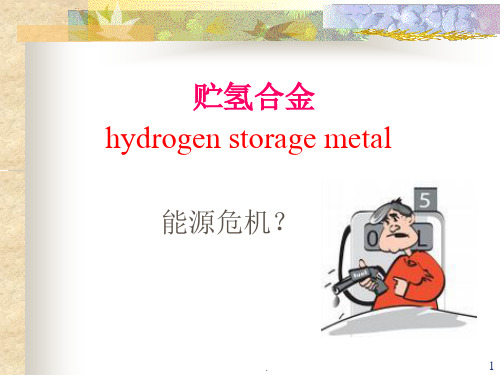
p
2 H
2
H M
A一B:为吸氢过程的第二步,固溶体进一步与氢反应,
产生相变,形成金属氢化物;
B点以后:为第三步,氢溶入氢化物形成固溶体,氢压
增加。
提高温度,平台压力升高,但有效氢 容量减少
.
21
p-c-T曲线是衡量贮氢材料热力学性能的重要特
性曲线。通过该图可以了解金属氢化物中能含多
少氢(%)和任一温度下的分解压力值。 p-c-T曲线
动植物的生存!!!
人类的出路何在?-新能源研究势在必
行!!!
.
2
对中国来说,首要的是开发水力资源和 生物质能,其次是发展地热能、风能和 太阳能。太阳能和风能的利用存在较大 的新材料问题。
太阳照射到地面的能量相当于全球能耗 的1.6万倍,既无污染,又是永久性能源。 可惜太阳辐射到地球的能量密度太低, 只有1kW/m2,还受气候影响。
.
3
太阳能的利用形式主要有两种:-是热能的直接 利用,如利用镜面或反射槽将太阳光聚焦在收 集器上,由中间介质吸热产生蒸汽,推动气轮 机组发电,美国单台容量己达80MW;另一种形 式是利用小型太阳能装置为房屋采暖供热,现 己大量应用。研制高效、长寿、廉价的光伏转 换材料已成为目前能源新材料领域的重要课题。
缺点:
氢吸、放动力学性能差:释放温度高, 250℃以上,反应速度慢,氢化困难
抗蚀能力差,特别是作为阴极贮氢合
金材料。
.
31
⑵稀土系合金
以LaNi5 为代表的稀土储氢合金被认为是所有 储氢合金中应用性能最好的一类,荷兰Philips实 验室首先研制
. 初期氢化容易, 反应速度快, 吸-放氢性能优良, 20℃ 时氢分解压仅几个大气压. 但是镧价格高, 循环退 化严重,易粉化.
储氢材料PPT演示课件

18
贮氢材料的发现和应用研究始于20世纪60年代, 1960年发现镁(Mg)能形成MgH2,其吸氢量高达(H)= 7.6%,但反应速度慢。
19Leabharlann 1964年,研制出Mg2Ni,其吸氢量为(H)=3.6%, 能在室温下吸氢和放氢,250 ℃时放氢压力约0.1MPa, 成为最早具有应用价值的贮氢材料。
36
2 n
M
(固)
H2
(气,
p)
吸氢,放热 放氢,吸热
2 n
MH
n
(固)
H
式中,M---金属; MHn---金属氢化物 P---氢压力;H---反应的焓变化
反应进行的方向取决于温度和氢压力。
37
2 n
M
(固)
H2
(气,
p)
吸氢,放热 放氢,吸热
2 n
MH
n
(固)
H
实际上,上式表示反应过程具有化学能(氢)、热能 (反应热)、机械能(平衡氢气压力)的贮存和相互转换功 能。
一般说,同一族从上至下还原性增强,同一周期从左至右 还原性减弱。
27
例如: 4NH3+5O2→4NO+6H2O 2PH3+4O2→P2O5+3H2O 2H2S+3O2→2SO2+2H2O 共价型氢化物在水中的行为较为复杂。常见为: 形成强酸的:HCl,HBr,HI; 形成弱酸的:HF,H2S,H2Se,H2Te; 形成碱的:NH3; 水解放出氢气的:B2H6,SiH4; 与水不作用的:CH4,PH3,AsH3,GeH4,SnH4,SbH3。
4LiH+AlCl3→LiAlH4+3LiCl 复合氢化物主要用做还原剂、引发剂和催化剂。
储氢材料综述ppt课件

15
铝氢化物
典型代表:LiAlH4
第三步反应温度在400℃以上,明显不适合车载使用。 因此以前两步为主,放氢量约7.9wt%
精选ppt课件2021
16
硼氢化物
典型代表:LiBH4
LiBH4 ↔LiH+B+3/2H2 (600K) ∆H=69kJ/molH2 放氢量约13.8wt%。
LiBH4中加入LiNH2反应如下: LiBH4+2LiNH2 ↔Li3BN2+4H2 (450K) ∆H=-23kJ/molH2。 放氢量约7.9wt%~9.5wt%。
精选ppt课件2021
21
氢化物反应失稳
氢化物反应失稳是通过添加适当的反应物来改变氢 化物的原有分解路径,以形成更加稳定的脱氢产物。[4]
AH2+B↔ABx+xB 反应焓较小,从而降低了 氢化物的分解温度,且易 于可逆加氢反应的进行
不同脱氢反应路径焓变示意图[3]
精选ppt课件2021
22
小结
I. 金属(合金)储氢存在着储氢量低等问题,常用改变 元素化学计量比、元素替代等方法改善其性能。
精选ppt课件2021
7
金属(合金)储氢材料分类:
A5B A2B AB
A元素:容易形成稳定 氢化物的放热型金属
B元素:难于形成氢化 物的吸热型金属
AB2
V和V基固溶体
精选ppt课件2021
8
AB5型
典型代表:LaNi5
室温下,与几个大气压的氢反应:
LaNi5+3H2 ↔LaNi5H6 储氢量约1.4wt%。
本过高。
精选ppt课件2021
5
化学方式储氢
金属(合金)储氢材料 络合氢化物储氢材料
碳纳米材料作为储氢材料相关

这些现象可由氢分子在孔中的局部密度分布来解释. 氢气在77 K 和 三个不同的压力p= 1121MPa, 4191 MPa, 1614 MPa 下的各个碳 管内的局部密度分布见图4. 从图4 可以看出, 在1121 MPa 的压力 下, 11225 nm 的碳管中的流体分子的第一层已经排满, 进一步的加 压只能使中心的一行分子的密度增加, 而这对分子数密度影响不大. 在2104 nm 和21719 nm 的碳管中, 当压力增加到4191 MPa 时, 最外层的已经接近排满, 而且第二层已经出现. 进一步增加压力对孔 内的分子数密度影响较小.
发现
1997年 , Dollin 等[3] 首先研究了单壁碳纳米管束的吸附储氢 能力, 并且发现在130 K 时储氢的重量百分比在5% ~ 10% 的范围 内, 接近或高于美国能源部的重量百分比为615 wt% 的目标. Ye 等 [ 4] 测量了高纯度的单壁碳纳米管束的吸附储氢能力, 他们发现在 80 K 和7 MPa 氢的存储能力高达8125 wt% , 并且在4 MPa 左右 氢的存储能力会有突然的升高. Liu 等[ 5]报道在300 K 和 1011MPa 的实验中发现碳纳米管束的储氢能力可达412 wt%
3 Dillon, A. C. ; Jones, K. M. ; Bekkadahl, T. A. ; Kiang, C. H. ; Bethune, D. S. ; Heben, M. J. Nature 1997,386 , 377. 4 Ye, Y. ; Ahn, C. C. ; Withem, C. ; Fultz, B. ; Liu, T. ;Rinzler, A. G. ; Colbert, D. ; Smith, K. A. ; Smalley, R.E. Appl . Phys . Lett . 1999, 74, 2307. 5 Liu, C. ; Fan, Y. Y. ; Liu, M. ; Cong, H. T. ; Cheng,H. M. ; Dresselhaus, M. S. Science 1999, 286 , 1127.
第四章储氢材料正式版ppt课件

经营者提供商品或者服务有欺诈行为 的,应 当按照 消费者 的要求 增加赔 偿其受 到的损 失,增 加赔偿 的金额 为消费 者购买 商品的 价款或 接受服 务的费 用
(1) 体积比较
经营者提供商品或者服务有欺诈行为 的,应 当按照 消费者 的要求 增加赔 偿其受 到的损 失,增 加赔偿 的金额 为消费 者购买 商品的 价款或 接受服 务的费 用
Position for H occupied at HSM
Hydrogen on Tetrahedral Sites
Hydrogen on Octahedral Sites
经营者提供商品或者服务有欺诈行为 的,应 当按照 消费者 的要求 增加赔 偿其受 到的损 失,增 加赔偿 的金额 为消费 者购买 商品的 价款或 接受服 务的费 用
▪ (LiAlH4在TiCl3、 TiCl4等催化下180℃ ,8MPa氢 压下获得5%的可逆储放氢容量)
经营者提供商品或者服务有欺诈行为 的,应 当按照 消费者 的要求 增加赔 偿其受 到的损 失,增 加赔偿 的金额 为消费 者购买 商品的 价款或 接受服 务的费 用
金属配位氢化物的主要性能
▪ 化石能源的使用正在给地球造成巨大的生态 灾难-温室效应、酸雨等严重威胁地球动植物的生存
▪ 人类的出路何在-新能源研究势在必行
经营者提供商品或者服务有欺诈行为 的,应 当按照 消费者 的要求 增加赔 偿其受 到的损 失,增 加赔偿 的金额 为消费 者购买 商品的 价款或 接受服 务的费 用
1.2 氢能开发,大势所趋
因此,高容量贮氢系统是贮氢材料研究 中长期探求的目标。
经营者提供商品或者服务有欺诈行为 的,应 当按照 消费者 的要求 增加赔 偿其受 到的损 失,增 加赔偿 的金额 为消费 者购买 商品的 价款或 接受服 务的费 用
储氢材料概述PPT课件
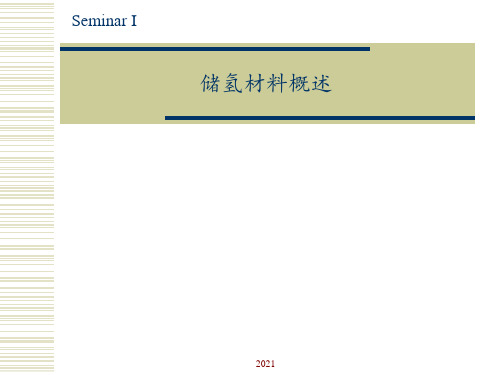
方法 大比表吸附剂
~1wt%
80K
纳米碳管
<2wt% 可逆存放量
金属氢化物 >100 g/l 化学 方法 有机液体 ~50 g/l
其他含氢物质 63/22 g/l
<2wt% 可实用速度吸\放氢量 ~7wt% 苯理论量 >4wt% 30%NaBH4溶液
2021/3/14
2021
8
日本加氢站
2021/3/14
Seminar I
储氢材料概述
2021/3/14
2021
1
一、绪言
氢-二十一世纪 的绿色能源
2021/3/14
2021
2
1.1能源危机与环境问题
化石能源的有限性与人类需求的无限性- 石油、煤炭等主要能源将在未来数十年至数百年内枯竭!!!
(科技日报,2004年2月25日,第二版)
化石能源的使用正在给地球造成巨大的生 态灾难-温室效应、酸雨等严重威胁地球动植物的生存!!!
子的吸附 TiMn1.5H2.5 日本松下(1.8%) Ti0.90Zr0.1Mn1.4V0.2Cr0.4 活性好 用于:氢汽车储氢、电池负极Ovinic
2021/3/14
2021
24
3.2配位氢化物储氢
碱金属(Li、Na、K)或碱土金属(Mg、 Ca)与第三主族元素(B、Al)形成
储氢容量高 再氢化难(LiAlH4在TiCl3、 TiCl4等催化下180℃ ,
2021
20
PCT curves of TiFe alloy
TiFe(40 ℃)
TiFe alloy
Characteristics:
❖ two hydride phases; ❖ phase (TiFeH1.04) & phase (TiFeH1.95 ) ❖ 2.13TiFeH0.10 + 1/2H2 → 2.13TiFeH1.04 ❖ 2.20TiFeH1.04 + 1/2H2 → 2.20TiFeH1.95
纳米储氢材料的制备与应用研究
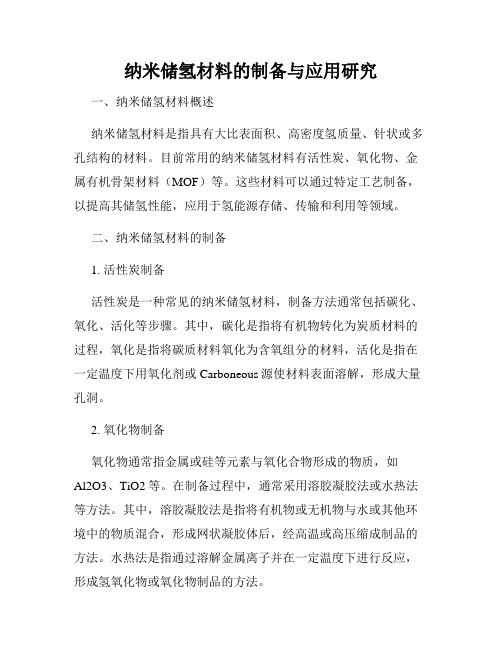
纳米储氢材料的制备与应用研究一、纳米储氢材料概述纳米储氢材料是指具有大比表面积、高密度氢质量、针状或多孔结构的材料。
目前常用的纳米储氢材料有活性炭、氧化物、金属有机骨架材料(MOF)等。
这些材料可以通过特定工艺制备,以提高其储氢性能,应用于氢能源存储、传输和利用等领域。
二、纳米储氢材料的制备1. 活性炭制备活性炭是一种常见的纳米储氢材料,制备方法通常包括碳化、氧化、活化等步骤。
其中,碳化是指将有机物转化为炭质材料的过程,氧化是指将碳质材料氧化为含氧组分的材料,活化是指在一定温度下用氧化剂或Carboneous源使材料表面溶解,形成大量孔洞。
2. 氧化物制备氧化物通常指金属或硅等元素与氧化合物形成的物质,如Al2O3、TiO2等。
在制备过程中,通常采用溶胶凝胶法或水热法等方法。
其中,溶胶凝胶法是指将有机物或无机物与水或其他环境中的物质混合,形成网状凝胶体后,经高温或高压缩成制品的方法。
水热法是指通过溶解金属离子并在一定温度下进行反应,形成氢氧化物或氧化物制品的方法。
3. 金属有机骨架材料制备金属有机骨架材料是一种通过金属离子与有机分子形成稳定的骨架结构,并在骨架空隙中填充储氢材料的材料。
目前,制备金属有机骨架材料的方法包括溶液或气相合成法、模板法、绿色化学法等。
三、纳米储氢材料应用研究1. 氢能源存储纳米储氢材料在氢能源存储中具有广泛应用。
目前,纳米储氢材料在氢气液化、压缩和固态储氢等多种形式的氢储存中都得到了应用。
例如,在氢气液化中,富勒烯和活性炭等材料可以作为填充材料来提高氢气的密度;在氢气压缩中,金属有机骨架材料可以作为填充材料来提高氢气储存密度。
2. 氢能源传输纳米储氢材料在氢能源传输中也得到了应用。
目前,在氢燃料电池技术中,纳米储氢材料可以作为电极材料来提高燃料电池的效率和稳定性。
3. 氢能源利用纳米储氢材料在氢能源利用中也具有广泛应用。
目前,氢燃料电池等技术已被用于汽车等领域,并得到了广泛关注。
纳米材料的储氢性能研究

纳米材料的储氢性能研究随着全球能源需求的不断增长和对环境污染的关注,寻找可再生、高效能源的研究变得尤为重要。
在这个背景下,纳米材料作为一种具有巨大潜力的材料种类,引起了广泛关注。
其中,纳米材料在储氢技术方面的应用研究备受关注。
本文将探讨纳米材料在储氢性能方面的研究进展,并为未来研究方向提供一些建议。
一、纳米材料的储氢原理纳米材料在储氢方面具有出色的性能。
这是由于纳米材料具有大比表面积和高扩散速率等特点所导致的。
当气体分子进入纳米材料结构时,由于其大比表面积,分子能够充分接触到材料表面,从而增加了吸附的机会。
同时,纳米材料具有较高的晶界能量,使得氢分子可以更容易地进出纳米材料,从而提高了储氢速率。
因此,纳米材料具有更高的储氢容量和降低储氢压力的潜力。
二、纳米材料在储氢材料方面的应用1. 碳基纳米材料碳基纳米材料是一种重要的纳米材料种类,在储氢领域具有广泛的应用价值。
其中,纳米碳管是一种具有良好的储氢性能的纳米材料。
由于其显著的比表面积和独特的空洞结构,纳米碳管具有出色的吸附能力和高储氢容量。
另外,石墨烯也是一种研究热点,它具有二维的结构和大面积的蜂窝状孔洞结构,为储氢提供了广阔的空间。
2. 金属基纳米材料金属基纳米材料是另一类具有潜力的储氢材料。
例如,纳米镁和纳米铝等金属材料具有较高的比表面积和很好的导热性能,使其具备优异的储氢性能。
此外,纳米合金材料也是受到广泛研究的领域,通过调控不同金属的比例和尺寸等参数,可以实现优化的储氢性能。
三、纳米材料在储氢性能研究中的挑战尽管纳米材料在储氢性能方面表现出优异的潜力,但仍然面临一些挑战和难题。
首先,纳米材料的制备和工艺需要更高的成本和技术条件。
同时,纳米材料在储氢过程中可能面临氢反应动力学慢、储氢容量损失等问题。
此外,纳米材料的稳定性和循环寿命也需要进一步的改进。
四、未来研究方向和展望为了进一步提高纳米材料的储氢性能,在未来的研究中,应该重点关注以下方面:1. 发展更多种类、更高效的制备方法,以降低纳米材料的成本和提高制备效率;2. 对纳米材料在储氢循环过程中的性能进行更加深入的研究,以了解其储氢机理,并改进其循环寿命和储氢容量;3. 基于计算模拟和理论分析,寻找并优化纳米材料的储氢性能;4. 探索纳米材料与其他材料的复合应用,以提升储氢性能;5. 加强纳米材料的稳定性研究,延长其在储氢系统中的寿命。
神奇的储氢材料――碳纳米管PPT课件

9
碳纳米管
Carbon nanotube (CNT)
由于纳米材料的研究热潮的带动,以碳和 纳米碳材料进行储氢成为新的研究热点。
10
纳米材料(1—100nm)的基本效应 1、小尺寸效应(体积效应) 2、量子尺寸效应 3、宏观量子隧道效应
4、表面效应
11
• 又叫巴基管,碳的同素异形体
2
氢能
hydrogen energy
3氢能被人们称ຫໍສະໝຸດ 理想的“绿色能源”氢能的优越性
1、安全环保:氢气分子量为2,比空气轻1/14,因此氢气泄露 空气中会自动逃离地面,不会形成聚集。而其他燃油燃气均会 聚集地面而构成易燃易爆危险。无味无毒,不会造成人体中毒, 燃料产物仅为水,不污染环境。 2、高温高能:1kg氢气的热值为34000Kcal, 是汽油的三倍。氢 氧焰温度高达2800度,高于常规液体。
31
学习总结
经常不断地学习,你就什么都知道。你知道得越多,你就越有力量 Study Constantly, And You Will Know Everything. The More
You Know, The More Powerful You Will Be
32
结束语
当你尽了自己的最大努力时,失败也是伟大的, 所以不要放弃,坚持就是正确的。
24
储氢量与储氢压力(温度)关系图
25
氢气释放问题:
2005年7月26日,美国NIST和Turkey's Bilkent大学发 现,钛修饰碳纳米管可以解决有效储氢的两个关键 问题:不但能够吸附足够数量的氢分子,而且可以 在加热时轻易地释放.
研究人员正在试图用碳纳米管制作轻便的可携带 式的储氢容器。
碳纳米管储氢材料合成与制备

可编辑ppt
2
一、氢能开发意义与现状
❖ 能源是国民经济的命脉,是人 ❖ 对于我国来说,虽然煤炭储量
类赖以生产、生活和生存的基础。 为世界第一,但化石能源的人均
在当今世界能源被称为科技发展 的三大支柱之一,是人类活动的
占有量低,且分布不均匀,这远
源泉。但是,随着社会经济的快 远不能满足我国经济高速增长的
总体来说,氢气储存有物理和化学两大类。 物理储氢方法: 液氢储存、高压氢气储存、活性炭吸附储存、玻璃微球储存、 地下岩洞储存等。 化学储存方法: 金属氢化物储存、有机液态氢化物储存、无机物储存、铁磁 性材料储存等等。
可编辑ppt
4
金属氢化物类储氢
❖ 1、镁系合金 ❖ 镁系合金是最早研究和被使
用的储氢合金。 ❖ 纯镁氢化物MgH2是惟一可
(三)钛系合金 钛系储氢合金分为Ti-Fe系和Ti-Mn系两类。 Ti-Fe系合金储氢量大,价格便宜,但缺点 是活化困难,抵抗杂质能力差、容易中毒。 可以用其他元素V、Cr、Mn,Co等代替部 分铁组成二元合金,活性大为改善。 Ti-Mn系合金中,以TiMn1.5二元合金的储 氢性能最好,而且在室温条件下即能活化, 反应速度快,反复吸释氢的能力强,而且 价可编格辑便pp宜t ,所以是一种很受重视应用的储 5 氢合金
2、稀土系合金
❖ 稀土系储氢合金以LaNi5为最典型的代表,是储 氢合金中应用性能最好的一种。
❖ 这种合金具有六方结构(CaCu5型)。它的最大优 点是在室温下就可以氢化,吸氢释氢均较容易, 且储氢密度高。但是它的缺点是价格太高,吸 氢和释氢的速度不够快。
❖ 为了让稀土系合金得到广泛的使用,开发研究 了新的系列合金(多元合金),主要有LaNi5三元 系合金和MnNi三元系合金。
纳米碳镁基固态氢存储材料

纳米碳镁基固态氢存储材料说到氢气,大家是不是第一反应就是那些科幻电影里的飞行器、清洁能源?对,就是那个号称“未来能源”的氢气,听起来是不是很高大上?不过呢,要想让氢气成为我们日常生活中的得力助手,首先得解决一个问题——怎么把氢气存储起来。
咱们不能总是用气瓶放吧?要是碰上个不小心,爆炸什么的,不知道的还以为电影情节呢。
所以,现在的科学家们就想了一个办法——用纳米碳镁基材料来做固态氢存储。
你可能会想,“这是什么鬼东西?”其实啊,纳米碳镁基材料是由两种成分组成的,一个是碳,另一个就是镁。
碳,大家都知道,常见的有石墨、炭黑这些东西;镁呢,就是我们常用的合金材料,轻得让人看了都觉得不靠谱。
不过,你别小看它们,这两个东西合起来做材料,效果杠杠的。
那为什么要用纳米碳镁基材料呢?这里面有个大秘密!纳米材料的表面积大得吓人,就像一块海绵,它能吸收好多氢气。
你想象一下,如果你有一块超大超大的海绵,能够吸水的地方越多,水吸得越多,氢气也一样,表面越大,氢气吸得就越多。
这样,氢气就能存储在固态材料中,不会乱跑,随时随地都能用。
而镁,它的特点是可以与氢气发生化学反应,形成固态氢化物,就好像氢气被镁“锁住”一样,稳定得很。
说起来,这种固态存储的技术就像是把氢气放进了一个“牢笼”,而这个牢笼又特别轻,能随身携带。
你想啊,像现在的电动车,氢气就可以作为动力源;要是能把氢气存储在小巧、稳定的材料里,这样的电动车岂不是飞起来了?再加上它能量密度高,充电快,反应又干净,简直是未来的交通工具呀。
可是,问题来了。
虽然这种方法听起来棒极了,可是实际操作起来并不那么简单。
镁和氢气结合得虽然牢固,但要让它们在合适的条件下释放出来也不容易。
要是环境条件不对,可能就成了“死物”了,根本释放不了氢气,白搭。
所以科学家们也在研究,怎么调整这个材料的结构,让它在需要的时候能快速释放氢气,而不是等到某一天才想起来:“哦,今天该放氢气了!”你看看,科学家们真是一个个的像大厨一样,调味的技术得够高,既得让镁和氢气“亲密接触”,又得保证它们不会“失控”。
纳米材料物理基础-纳米材料的储氢
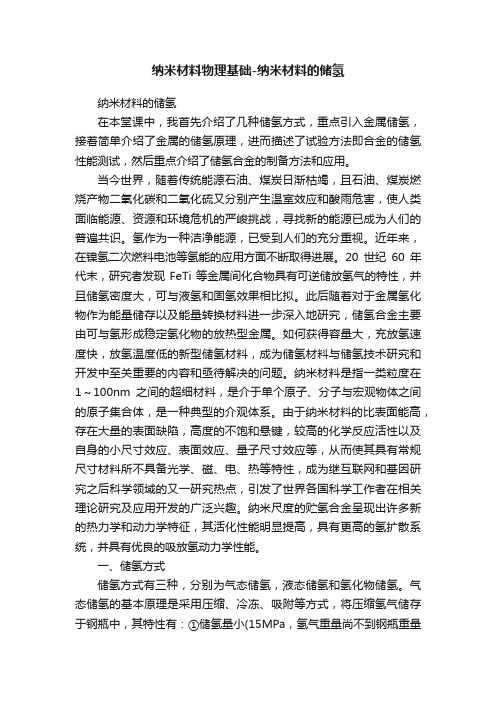
纳米材料物理基础-纳米材料的储氢纳米材料的储氢在本堂课中,我首先介绍了几种储氢方式,重点引入金属储氢,接着简单介绍了金属的储氢原理,进而描述了试验方法即合金的储氢性能测试,然后重点介绍了储氢合金的制备方法和应用。
当今世界,随着传统能源石油、煤炭日渐枯竭,且石油、煤炭燃烧产物二氧化碳和二氧化硫又分别产生温室效应和酸雨危害,使人类面临能源、资源和环境危机的严峻挑战,寻找新的能源已成为人们的普遍共识。
氢作为一种洁净能源,已受到人们的充分重视。
近年来,在镍氢二次燃料电池等氢能的应用方面不断取得进展。
20世纪60年代末,研究者发现FeTi等金属间化合物具有可逆储放氢气的特性,并且储氢密度大,可与液氢和固氢效果相比拟。
此后随着对于金属氢化物作为能量储存以及能量转换材料进一步深入地研究,储氢合金主要由可与氢形成稳定氢化物的放热型金属。
如何获得容量大,充放氢速度快,放氢温度低的新型储氢材料,成为储氢材料与储氢技术研究和开发中至关重要的内容和亟待解决的问题。
纳米材料是指一类粒度在1~100nm之间的超细材料,是介于单个原子、分子与宏观物体之间的原子集合体,是一种典型的介观体系。
由于纳米材料的比表面能高,存在大量的表面缺陷,高度的不饱和悬键,较高的化学反应活性以及自身的小尺寸效应、表面效应、量子尺寸效应等,从而使其具有常规尺寸材料所不具备光学、磁、电、热等特性,成为继互联网和基因研究之后科学领域的又一研究热点,引发了世界各国科学工作者在相关理论研究及应用开发的广泛兴趣。
纳米尺度的贮氢合金呈现出许多新的热力学和动力学特征,其活化性能明显提高,具有更高的氢扩散系统,并具有优良的吸放氢动力学性能。
一、储氢方式储氢方式有三种,分别为气态储氢,液态储氢和氢化物储氢。
气态储氢的基本原理是采用压缩、冷冻、吸附等方式,将压缩氢气储存于钢瓶中,其特性有:①储氢量小(15MPa,氢气重量尚不到钢瓶重量的1/100);②使用不方便;③有一定的危险性。
- 1、下载文档前请自行甄别文档内容的完整性,平台不提供额外的编辑、内容补充、找答案等附加服务。
- 2、"仅部分预览"的文档,不可在线预览部分如存在完整性等问题,可反馈申请退款(可完整预览的文档不适用该条件!)。
- 3、如文档侵犯您的权益,请联系客服反馈,我们会尽快为您处理(人工客服工作时间:9:00-18:30)。
NATURE MATERIALS DOI: 10.1038/NMAT2978
a
d
LETTERS
(100) (002) (101) (102) (110) (103)
After synthesis
Fraction
Cumulative fraction
0.4 0.3 0.2 0.1
00
2468 Particle size (nm)
temperature from a homogeneous tetrahydrofuran (THF) solution containing the following dissolved components: the organometallic precursor bis(cyclopentadienyl)magnesium (Cp2Mg), the reducing agent lithium naphthalide, and the gas-selective polymer poly(methyl methacrylate) (PMMA). Mg nanocrystals are then nucleated and grown in this solution by means of a burst-nucleation and growth mechanism13 in which lithium naphthalide reduces the organometallic precursor in the presence of a capping ligand (the soluble PMMA (Mw = 120,000) acts as a capping ligand for the Mg nanocrystals)14. Transmission electron microscopy (TEM) analysis of our reaction mixture before addition of reductant, immediately thereafter, and at later stages of the growth (Supplementary Fig. S1) further support this model.
for hydrogen and decreasing the required thickness of the
poorly permeable hydride layer that forms during absorption.
Here, we report the synthesis of an air-stable composite ma-
b
Mg2+
+
Li
Bis(cyclopentadienyl)magnesium
Lithium naphthalide
Organic polymer with selective gas permeability
PMMA THF
Mg/PMMA nanocomposites
Figure 1 | Mg NCs in a gas-barrier polymer matrix. a, Schematic of
recent theoretical calculations6,7 and metal-catalysed thin-film
studies8 have shown that microstructuring of these materials
can enhance the kinetics by decreasing diffusion path lengths
There have been various efforts to synthesize nanosized magnesium, such as ball-milling9, sonoelectrochemistry10, gasphase condensation11 and infiltration of nanoporous carbon with molten magnesium12. However, these approaches remain
hydrogen storage composite material: high-capacity Mg NCs are encapsulated by a selectively gas-permeable polymer. b, Synthetic approach to formation of Mg NCs/PMMA nanocomposites.
Ulsan 689-798, Korea. *e-mail: jjurban@.
286
NATURE MATERIALS | VOL 10 | APRIL 2011 | /naturematerials
© 2011 Macmillan Publishers Limited. All rights reserved
of potential sources (for example water, biomass, organic
matter), light weight, and low environmental impact (water
is the sole combustion product). However, there remains a
their high bond formation a Hf ∼ 75 kJ mol−1), thus
enthalpies (for example MgH2 has requiring unacceptably high release
temperatures5 resulting in low energy efficiency. However,
limited by inhomogeneous size distributions and high reactivity
toward oxygen. Our synthesis for air-stable alkaline earth metal
NC/polymer composites consists of a one-pot reduction reaction of an organometallic Mg2+ precursor in the presence of a soluble
materials4, physisorb only a small amount of hydrogen (typ-
ically 1–2 wt%) at room temperature. Metal hydrides were
traditionally thought to be unsuitable materials because of
LETTERS
PUBLISHED ONLINE: 13 MARCH 2011 | DOI: 10.1038/NMAT2978
Air-stable magnesium nanocomposites provide rapid and high-capacity hydrogen storage without using heavy-metal catalysts
organic polymer chosen for its hydrogen gas selectivity (Fig. 1).
The Mg NCs/PMMA nanocomposites were synthesized at room
a
O2
பைடு நூலகம்
H2O
H2
Formation of MgH2
H2
Mg nanoparticle
Ki-Joon Jeon1†, Hoi Ri Moon2†‡, Anne M. Ruminski2, Bin Jiang3, Christian Kisielowski4, Rizia Bardhan2
and Jeffrey J. Urban2*
Hydrogen is a promising alternative energy carrier that can
challenge to produce a material capable of simultaneously op-
timizing two conflicting criteria—absorbing hydrogen strongly
enough to form a stable thermodynamic state, but weakly
potentially facilitate the transition from fossil fuels to sources
of clean energy because of its prominent advantages such
as high energy density (142 MJ kg−1; ref. 1), great variety
contributed equally to this work. ‡Present address: Interdisciplinary School of Green Energy, Ulsan National Institute of Science and Technology (UNIST),
terial that consists of metallic Mg nanocrystals (NCs) in a
gas-barrier polymer matrix that enables both the storage of a
high density of hydrogen (up to 6 wt% of Mg, 4 wt% for the
